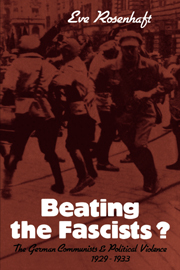Book contents
- Frontmatter
- Contents
- Preface
- List of abbreviations
- Map 1 Greater Berlin 1930
- Map 2 Central Berlin 1930
- 1 Introduction: Social crisis, radical politics and organized violence in Weimar Germany
- 2 The Party, the neighbourhood and the uses of violence in the ‘Third Period’
- 3 Defining the enemy: The wehrhafter Kampf against the SA in theory and propaganda
- 4 Organizing the wehrhafter Kampf: The Communist defence formations
- 5 Between ‘individual terror’ and ‘mass terror’: The campaign against the SA-taverns, 1931
- 6 The shape of violence in the neighbourhoods
- 7 Who were the streetfighters?
- 8 Conclusion: Communist politics in the Weimar Republic
- A note on sources
- Notes
- Bibliography
- Index
4 - Organizing the wehrhafter Kampf: The Communist defence formations
Published online by Cambridge University Press: 05 March 2012
- Frontmatter
- Contents
- Preface
- List of abbreviations
- Map 1 Greater Berlin 1930
- Map 2 Central Berlin 1930
- 1 Introduction: Social crisis, radical politics and organized violence in Weimar Germany
- 2 The Party, the neighbourhood and the uses of violence in the ‘Third Period’
- 3 Defining the enemy: The wehrhafter Kampf against the SA in theory and propaganda
- 4 Organizing the wehrhafter Kampf: The Communist defence formations
- 5 Between ‘individual terror’ and ‘mass terror’: The campaign against the SA-taverns, 1931
- 6 The shape of violence in the neighbourhoods
- 7 Who were the streetfighters?
- 8 Conclusion: Communist politics in the Weimar Republic
- A note on sources
- Notes
- Bibliography
- Index
Summary
The banning of the RFB at a time when all signs pointed to a new round of brutal repression from above and revolutionary action from below was a double blow to the Communist Party. It had been deprived of the organizational framework in which an effective self-defence movement might have been developed; this, at least, was what the Party publicists continued to argue for the next three-and-a-half years. At the same time, the KPD had lost one of its most popular and successful united-front organs. Since its earliest years, the RFB's defence functions had been ancillary to its broader purpose as a mass-organization: to draw non-Communists into the movement, to spread propaganda, especially through ‘antimilitarist’ agitation, and to carry argument and discussion into the ranks of the army, police and other paramilitary formations, most notably the Reichsbanner.
In the discussions over possible replacements for the RFB, Party tacticians were wont to stress that the tasks of the ‘Third Period’ required a new kind of organization. Significantly, the functions of active self-defence were explicitly emphasized in contrast to the popular propaganda, parades and ‘militaristic Brimborium’ appropriate to the years of social peace. But as long as the gathering-in of the masses remained the immediate aim of the Party, this distinction was imperfectly realized. The military and defence organizations of the KPD translated into practice a by now familiar set of tensions: between the principles of cadre- and mass-organization, of factory and neighbourhood, of propaganda and technical efficiency.
- Type
- Chapter
- Information
- Beating the Fascists?The German Communists and Political Violence 1929–1933, pp. 88 - 110Publisher: Cambridge University PressPrint publication year: 1983



